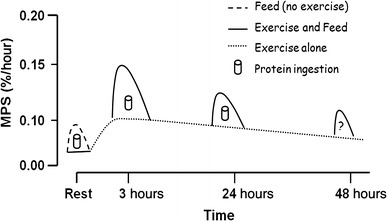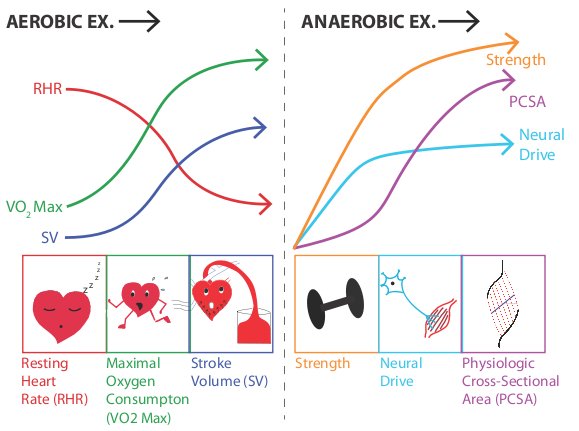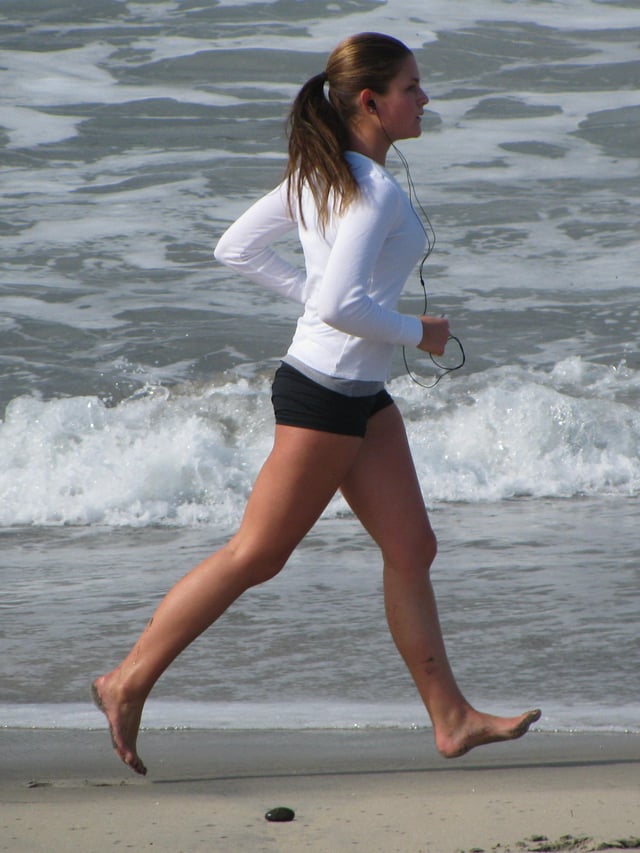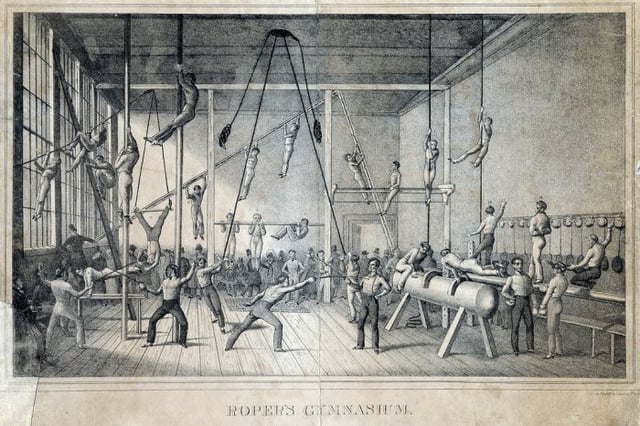Physical exercise

Physical exercise


Running in water
Exercise is any bodily activity that enhances or maintains physical fitness and overall health and wellness.[1] It is performed for various reasons, to aid growth and improve strength, preventing aging, developing muscles and the cardiovascular system, honing athletic skills, weight loss or maintenance, improving health[2] and also for enjoyment. Many individuals choose to exercise outdoors where they can congregate in groups, socialize, and enhance well-being.[3]
Classification

An astronaut, Daniel Tani, working out with a short bar to increase his upper body strength while in a microgravity environment
Physical exercises are generally grouped into three types, depending on the overall effect they have on the human body:[4]
Aerobic exercise is any physical activity that uses large muscle groups and causes the body to use more oxygen than it would while resting.[4] The goal of aerobic exercise is to increase cardiovascular endurance.[5] Examples of aerobic exercise include running, cycling, swimming, brisk walking, skipping rope, rowing, hiking, dancing, playing tennis, continuous training, and long distance running.[4]
Anaerobic exercise, which includes strength and resistance training, can firm, strengthen, and increase muscle mass, as well as improve bone density, balance, and coordination.[4] Examples of strength exercises are push-ups, pull-ups, lunges, squats, bench press. Anaerobic exercise also include weight training, functional training, eccentric training, interval training, sprinting, and high-intensity interval training increase short-term muscle strength.[4][6]
Flexibility exercises stretch and lengthen muscles.[4] Activities such as stretching help to improve joint flexibility and keep muscles limber.[4] The goal is to improve the range of motion which can reduce the chance of injury.[4][7]
Sometimes the terms 'dynamic' and 'static' are used. 'Dynamic' exercises such as steady running, tend to produce a lowering of the diastolic blood pressure during exercise, due to the improved blood flow. Conversely, static exercise (such as weight-lifting) can cause the systolic pressure to rise significantly, albeit transiently, during the performance of the exercise.[9]
Health effects
| Type of adaptation | Endurance training effects | Strength training effects | Sources |
|---|---|---|---|
Skeletal muscle morphology and exercise performance adaptations | |||
| Muscle hypertrophy | ↔ | ↑ ↑ ↑ | [10] |
| Muscle strength and power | ↔ ↓ | ↑ ↑ ↑ | [10] |
| Muscle fiber size | ↔ ↑ | ↑ ↑ ↑ | [10] |
| Myofibrillar protein synthesis | ↔ ↑ | ↑ ↑ ↑ | [10] |
| Neuromuscular adaptations | ↔ ↑ | ↑ ↑ ↑ | [10] |
| Anaerobic capacity | ↑ | ↑ ↑ | [10] |
| Lactate tolerance | ↑ ↑ | ↔ ↑ | [10] |
| Endurance capacity | ↑ ↑ ↑ | ↔ ↑ | [10] |
| Capillary growth (angiogenesis) | ↑ ↑ | ↔ | [10] |
| Mitochondrial biogenesis | ↑ ↑ | ↔ ↑ | [10] |
| Mitochondrial density and oxidative function | ↑ ↑ ↑ | ↔ ↑ | [10] |
Whole-body and metabolic adaptations | |||
| Bone mineral density | ↑ ↑ | ↑ ↑ | [10] |
| Inflammatory markers | ↓ ↓ | ↓ | [10] |
| Flexibility | ↑ | ↑ | [10] |
| Posture | ↔ | ↑ | [10] |
| Ability in activities of daily living | ↔ ↑ | ↑ ↑ | [10] |
| Basal metabolic rate | ↑ | ↑ ↑ | [10] |
Body composition | |||
| Percent body fat | ↓ ↓ | ↓ | [10] |
| Lean body mass | ↔ | ↑ ↑ | [10] |
Glucose metabolism | |||
| Resting insulin levels | ↓ | ↓ | [10] |
| Insulin sensitivity | ↑ ↑ | ↑ ↑ | [10] |
| Insulin response to glucose challenge | ↓ ↓ | ↓ ↓ | [10] |
Cardiovascular adaptations | |||
| Resting heart rate | ↓ ↓ | ↔ | [10] |
| Stroke volume (resting and maximal) | ↑ ↑ | ↔ | [10] |
| Systolic blood pressure (resting) | ↔ ↓ | ↔ | [10] |
| Diastolic blood pressure (resting) | ↔ ↓ | ↔ ↓ | [10] |
| Cardiovascular risk profile | ↓ ↓ ↓ | ↓ | [10] |
Table legend
| |||
Physical exercise is important for maintaining physical fitness and can contribute to maintaining a healthy weight, regulating the digestive system, building and maintaining healthy bone density, muscle strength, and joint mobility, promoting physiological well-being, reducing surgical risks, and strengthening the immune system. Some studies indicate that exercise may increase life expectancy and the overall quality of life.[11] People who participate in moderate to high levels of physical exercise have a lower mortality rate compared to individuals who by comparison are not physically active.[12] Moderate levels of exercise have been correlated with preventing aging by reducing inflammatory potential.[13] The majority of the benefits from exercise are achieved with around 3500 metabolic equivalent (MET) minutes per week, with diminishing returns at higher levels of activity.[14] For example, climbing stairs 10 minutes, vacuuming 15 minutes, gardening 20 minutes, running 20 minutes, and walking or bicycling for transportation 25 minutes on a daily basis would together achieve about 3000 MET minutes a week.[14] A lack of physical activity causes approximately 6% of the burden of disease from coronary heart disease, 7% of type 2 diabetes, 10% of breast cancer and 10% of colon cancer worldwide.[15] Overall, physical inactivity causes 9% of premature mortality worldwide.[15]
Fitness
Individuals can increase fitness following increases in physical activity levels.[16] Increases in muscle size from resistance training is primarily determined by diet and testosterone.[17] This genetic variation in improvement from training is one of the key physiological differences between elite athletes and the larger population.[18][19] Studies have shown that exercising in middle age leads to better physical ability later in life.[20]
Early motor skills and development have also shown to be related to physical activity and performance later in life. Children who have more proficient motor skills early on are more inclined to being physically active, and thus tend to perform well in sports and have better fitness levels. Early motor proficiency has a positive correlation to childhood physical activity and fitness levels, while less proficiency in motor skills results in a tendency to partake in a more sedentary lifestyle.[21]
A 2015 meta-analysis demonstrated that high intensity training improved stamina more than lower intensity endurance training.[22]
Cardiovascular system
The beneficial effect of exercise on the cardiovascular system is well documented. There is a direct correlation between physical inactivity and cardiovascular mortality, and physical inactivity is an independent risk factor for the development of coronary artery disease. Low levels of physical exercise increase the risk of cardiovascular diseases mortality.[23]
Children who participate in physical exercise experience greater loss of body fat and increased cardiovascular fitness.[24] Studies have shown that academic stress in youth increases the risk of cardiovascular disease in later years; however, these risks can be greatly decreased with regular physical exercise.[25] There is a dose-response relation between the amount of exercise performed from approximately 700–2000 kcal of energy expenditure per week and all-cause mortality and cardiovascular disease mortality in middle-aged and elderly men. The greatest potential for reduced mortality is in the sedentary who become moderately active. Studies have shown that since heart disease is the leading cause of death in women, regular exercise in aging women leads to healthier cardiovascular profiles. Most beneficial effects of physical activity on cardiovascular disease mortality can be attained through moderate-intensity activity (40–60% of maximal oxygen uptake, depending on age). Persons who modify their behavior after myocardial infarction to include regular exercise have improved rates of survival. Persons who remain sedentary have the highest risk for all-cause and cardiovascular disease mortality.[26] According to the American Heart Association, exercise reduces the risk of cardiovascular diseases, including heart attack and stroke.[23]
Immune system
Although there have been hundreds of studies on physical exercise and the immune system, there is little direct evidence on its connection to illness.[27] Epidemiological evidence suggests that moderate exercise has a beneficial effect on the human immune system; an effect which is modeled in a J curve. Moderate exercise has been associated with a 29% decreased incidence of upper respiratory tract infections (URTI), but studies of marathon runners found that their prolonged high-intensity exercise was associated with an increased risk of infection occurrence.[27] However, another study did not find the effect. Immune cell functions are impaired following acute sessions of prolonged, high-intensity exercise, and some studies have found that athletes are at a higher risk for infections. Studies have shown that strenuous stress for long durations, such as training for a marathon, can suppress the immune system by decreasing the concentration of lymphocytes.[28] The immune systems of athletes and nonathletes are generally similar. Athletes may have slightly elevated natural killer cell count and cytolytic action, but these are unlikely to be clinically significant.[27]
Vitamin C supplementation has been associated with lower incidence of upper respiratory tract infections in marathon runners.[27]
Biomarkers of inflammation such as C-reactive protein, which are associated with chronic diseases, are reduced in active individuals relative to sedentary individuals, and the positive effects of exercise may be due to its anti-inflammatory effects. In individuals with heart disease, exercise interventions lower blood levels of fibrinogen and C-reactive protein, an important cardiovascular risk marker.[29] The depression in the immune system following acute bouts of exercise may be one of the mechanisms for this anti-inflammatory effect.[27]
Cancer
A systematic review evaluated 45 studies that examined the relationship between physical activity and cancer survival rates. According to the review, "[there] was consistent evidence from 27 observational studies that physical activity is associated with reduced all-cause, breast cancer–specific, and colon cancer–specific mortality. There is currently insufficient evidence regarding the association between physical activity and mortality for survivors of other cancers."[30] Although there is only limited scientific evidence on the subject, people with cancer cachexia are encouraged to engage in physical exercise.[31] Due to various factors, some individuals with cancer cachexia have a limited capacity for physical exercise.[32][33] Compliance with prescribed exercise is low in individuals with cachexia and clinical trials of exercise in this population often suffer from high drop-out rates.[32][33]
Neurobiological
The neurobiological effects of physical exercise are numerous and involve a wide range of interrelated effects on brain structure, brain function, and cognition.[34][35][36][37] A large body of research in humans has demonstrated that consistent aerobic exercise (e.g., 30 minutes every day) induces persistent improvements in certain cognitive functions, healthy alterations in gene expression in the brain, and beneficial forms of neuroplasticity and behavioral plasticity; some of these long-term effects include: increased neuron growth, increased neurological activity (e.g., c-Fos and BDNF signaling), improved stress coping, enhanced cognitive control of behavior, improved declarative, spatial, and working memory, and structural and functional improvements in brain structures and pathways associated with cognitive control and memory.[34][35][36][37][38][39][40][41][42][43] The effects of exercise on cognition have important implications for improving academic performance in children and college students, improving adult productivity, preserving cognitive function in old age, preventing or treating certain neurological disorders, and improving overall quality of life.[34][44][45]
In healthy adults, aerobic exercise has been shown to induce transient effects on cognition after a single exercise session and persistent effects on cognition following regular exercise over the course of several months.[34][43][46] People who regularly perform aerobic exercise (e.g., running, jogging, brisk walking, swimming, and cycling) have greater scores on neuropsychological function and performance tests that measure certain cognitive functions, such as attentional control, inhibitory control, cognitive flexibility, working memory updating and capacity, declarative memory, spatial memory, and information processing speed.[34][38][40][42][43][46] The transient effects of exercise on cognition include improvements in most executive functions (e.g., attention, working memory, cognitive flexibility, inhibitory control, problem solving, and decision making) and information processing speed for a period of up to 2 hours after exercising.[46]
Aerobic exercise induces short- and long-term effects on mood and emotional states by promoting positive affect, inhibiting negative affect, and decreasing the biological response to acute psychological stress.[46] Over the short-term, aerobic exercise functions as both an antidepressant and euphoriant,[47][48][49][50] whereas consistent exercise produces general improvements in mood and self-esteem.[51][52]
Regular aerobic exercise improves symptoms associated with a variety of central nervous system disorders and may be used as an adjunct therapy for these disorders. There is clear evidence of exercise treatment efficacy for major depressive disorder and attention deficit hyperactivity disorder.[44][49][53][54][55][56] The American Academy of Neurology's clinical practice guideline for mild cognitive impairment indicates that clinicians should recommend regular exercise (two times per week) to individuals who have been diagnosed with this condition.[57] Reviews of clinical evidence also support the use of exercise as an adjunct therapy for certain neurodegenerative disorders, particularly Alzheimer’s disease and Parkinson's disease.[58][59][60][61][62][63] Regular exercise is also associated with a lower risk of developing neurodegenerative disorders.[61][64] A large body of preclinical evidence and emerging clinical evidence supports the use of exercise as an adjunct therapy for the treatment and prevention of drug addictions.[65][66][67][68][69] Regular exercise has also been proposed as an adjunct therapy for brain cancers.[70]
Depression
A number of medical reviews have indicated that exercise has a marked and persistent antidepressant effect in humans,[38][49][50][53][71][72] an effect believed to be mediated through enhanced BDNF signaling in the brain.[41][53] Several systematic reviews have analyzed the potential for physical exercise in the treatment of depressive disorders. The 2013 Cochrane Collaboration review on physical exercise for depression noted that, based upon limited evidence, it is more effective than a control intervention and comparable to psychological or antidepressant drug therapies.[71] Three subsequent 2014 systematic reviews that included the Cochrane review in their analysis concluded with similar findings: one indicated that physical exercise is effective as an adjunct treatment (i.e., treatments that are used together) with antidepressant medication;[53] the other two indicated that physical exercise has marked antidepressant effects and recommended the inclusion of physical activity as an adjunct treatment for mild–moderate depression and mental illness in general.[49][50] One systematic review noted that yoga may be effective in alleviating symptoms of prenatal depression.[73] Another review asserted that evidence from clinical trials supports the efficacy of physical exercise as a treatment for depression over a 2–4 month period.[38]
A 2015 review of clinical evidence which included a medical guideline for the treatment of depression with exercise noted that the available evidence on the effectiveness of exercise therapy for depression suffers from some limitations;[54] nonetheless, it stated that there is clear evidence of efficacy for reducing symptoms of depression.[54] The review also noted that patient characteristics, the type of depressive disorder, and the nature of the exercise program all affect the antidepressant properties of exercise therapy.[54] A meta-analysis from July 2016 concluded that physical exercise improves overall quality of life in individuals with depression relative to controls.[44]
Continuous aerobic exercise can induce a transient state of euphoria, colloquially known as a "runner's high" in distance running or a "rower's high" in crew, through the increased biosynthesis of at least three euphoriant neurochemicals: anandamide (an endocannabinoid),[74] β-endorphin (an endogenous opioid),[75] and phenethylamine (a trace amine and amphetamine analog).[76][77][78]
Sleep
Preliminary evidence from a 2012 review indicated that physical training for up to four months may increase sleep quality in adults over 40 years of age.[79] A 2010 review suggested that exercise generally improved sleep for most people, and may help with insomnia, but there is insufficient evidence to draw detailed conclusions about the relationship between exercise and sleep.[80] A 2018 systematic review and meta-analysis suggested that exercise can improve sleep quality in people with insomnia.[81]
Excessive exercise
Too much exercise can be harmful. Without proper rest, the chance of stroke or other circulation problems increases,[82] and muscle tissue may develop slowly. Extremely intense, long-term cardiovascular exercise, as can be seen in athletes who train for multiple marathons, has been associated with scarring of the heart and heart rhythm abnormalities.[83][84][85] Specifically, high cardiac output has been shown to cause enlargement of the left and right ventricle volumes, increased ventricle wall thickness, and greater cardiac mass. These changes further result in myocardial cell damage in the lining of the heart, leading to scar tissue and thickened walls. During these processes, the protein troponin increases in the bloodstream, indicating cardiac muscle cell death and increased stress on the heart itself.[86]
Inappropriate exercise can do more harm than good, with the definition of “inappropriate” varying according to the individual. For many activities, especially running and cycling, there are significant injuries that occur with poorly regimented exercise schedules. Injuries from accidents also remain a major concern,[87] whereas the effects of increased exposure to air pollution seem only a minor concern.[88][89]
In extreme instances, over-exercising induces serious performance loss. Unaccustomed overexertion of muscles leads to rhabdomyolysis (damage to muscle) most often seen in new army recruits.[90] Another danger is overtraining, in which the intensity or volume of training exceeds the body's capacity to recover between sessions. One result of detrimental overtraining is suppressed immune function, with an increased incidence of upper respiratory tract infection (URTI). An increased incidence of URTIs is also associated with high volume/intensity training, as well as with excessive exercise (EE), such as in a marathon.[91] Marathon training requires the runner to build their intensity week to week which makes them more susceptible to injury the more they increase their mileage. A study shows that in the last 10–15 years up to 90% of marathon runners have suffered a physical injury from their training.[92]
Stopping excessive exercise suddenly may create a change in mood. Exercise should be controlled by each body's inherent limitations. While one set of joints and muscles may have the tolerance to withstand multiple marathons, another body may be damaged by 20 minutes of light jogging. As every individual is different, this must be determined for each individual. Particularly, for athletes, the goal of training is to push performance capacity to its upper limit, however, there is a small threshold between peak performance and overtraining.[93]
Too much exercise can also lead to, or be a result of, exercise addiction. There is not much conclusive research on exercise addiction but the general conclusion on stress in relation to exercise is that exercise is inversely related to anxiety and depression. In other words, evidence suggests that exercise decreases the negative effects associated with depression and anxiety. The desire for relieving these negative emotions is a possible cause for exercise addiction. Individuals labeled as exercise-dependent (exercise addicts) show similar behaviors and hormone levels to those with alcoholism and drug addictions. Similar to various other models of addiction, there are stages that define exercise addiction. There are multiple models but one case study consists of the stages: salience, euphoria, tolerance, withdrawal, conflict, and relapse. These stages are associated with some symptoms of exercise addiction which include some or a combination of withdrawal, feeling a lack of control and unable to cut down on exercise, depression, anxiety and insomnia. The cause of exercise addiction could be based on physiological or psychological factors, or a combination between the two, but it has not yet been established.[94]
Mechanism of effects
Skeletal muscle

Resistance training stimulates muscle protein synthesis (MPS) for a period of up to 48 hours following exercise (shown by dotted line).[96] Ingestion of a protein-rich meal at any point during this period will augment the exercise-induced increase in muscle protein synthesis (shown by solid lines).[96]

Diagram of the molecular signaling cascades that are involved in myofibrillar muscle protein synthesis and mitochondrial biogenesis in response to physical exercise and specific amino acids or their derivatives (primarily L-leucine and HMB).[95] Many amino acids derived from food protein promote the activation of mTORC1 and increase protein synthesis by signaling through Rag GTPases.[95][104]Abbreviations and representations • PLD: phospholipase D • PA: phosphatidic acid • mTOR: mechanistic target of rapamycin • AMP: adenosine monophosphate • ATP: adenosine triphosphate • AMPK: AMP-activated protein kinase • PGC‐1α: peroxisome proliferator-activated receptor gamma coactivator-1α • S6K1: p70S6 kinase • 4EBP1: eukaryotic translation initiation factor 4E-binding protein 1 • eIF4E: eukaryotic translation initiation factor 4E • RPS6: ribosomal protein S6 • eEF2: eukaryotic elongation factor 2 • RE: resistance exercise; EE: endurance exercise • Myo: myofibrillar; Mito: mitochondrial • AA: amino acids • HMB: β-hydroxy β-methylbutyric acid • ↑ represents activation • Τ represents inhibition
Resistance training and subsequent consumption of a protein-rich meal promotes muscle hypertrophy and gains in muscle strength by stimulating myofibrillar muscle protein synthesis (MPS) and inhibiting muscle protein breakdown (MPB).[95][96] The stimulation of muscle protein synthesis by resistance training occurs via phosphorylation of the mechanistic target of rapamycin (mTOR) and subsequent activation of mTORC1, which leads to protein biosynthesis in cellular ribosomes via phosphorylation of mTORC1's immediate targets (the p70S6 kinase and the translation repressor protein 4EBP1).[95][97] The suppression of muscle protein breakdown following food consumption occurs primarily via increases in plasma insulin.[95][98][99] Similarly, increased muscle protein synthesis (via activation of mTORC1) and suppressed muscle protein breakdown (via insulin-independent mechanisms) has also been shown to occur following ingestion of β-hydroxy β-methylbutyric acid.[95][98][99][100]
Aerobic exercise induces mitochondrial biogenesis and an increased capacity for oxidative phosphorylation in the mitochondria of skeletal muscle, which is one mechanism by which aerobic exercise enhances submaximal endurance performance.[101] [95][102] These effects occur via an exercise-induced increase in the intracellular AMP:ATP ratio, thereby triggering the activation of AMP-activated protein kinase (AMPK) which subsequently phosphorylates peroxisome proliferator-activated receptor gamma coactivator-1α (PGC-1α), the master regulator of mitochondrial biogenesis.[95][102][103]
Other peripheral organs

Summary of long-term adaptations to regular aerobic and anaerobic exercise. Aerobic exercise can cause several central cardiovascular adaptations, including an increase in stroke volume (SV)[105] and maximal aerobic capacity (VO2 max),[105][106] as well as a decrease in resting heart rate (RHR).[107][108][109] Long-term adaptations to resistance training, the most common form of anaerobic exercise, include muscular hypertrophy,[110][111] an increase in the physiological cross-sectional area (PCSA) of muscle(s), and an increase in neural drive,[112][113] both of which lead to increased muscular strength.[114] Neural adaptations begin more quickly and plateau prior to the hypertrophic response.[115][116]
Developing research has demonstrated that many of the benefits of exercise are mediated through the role of skeletal muscle as an endocrine organ. That is, contracting muscles release multiple substances known as myokines which promote the growth of new tissue, tissue repair, and multiple anti-inflammatory functions, which in turn reduce the risk of developing various inflammatory diseases.[117] Exercise reduces levels of cortisol, which causes many health problems, both physical and mental.[118] Endurance exercise before meals lowers blood glucose more than the same exercise after meals.[119] There is evidence that vigorous exercise (90–95% of VO2 max) induces a greater degree of physiological cardiac hypertrophy than moderate exercise (40 to 70% of VO2 max), but it is unknown whether this has any effects on overall morbidity and/or mortality.[120] Both aerobic and anaerobic exercise work to increase the mechanical efficiency of the heart by increasing cardiac volume (aerobic exercise), or myocardial thickness (strength training). Ventricular hypertrophy, the thickening of the ventricular walls, is generally beneficial and healthy if it occurs in response to exercise.
Central nervous system
Public health measures
Multiple component community-wide campaigns are frequently used in an attempt to increase a population's level of physical activity. A 2015 Cochrane review, however, did not find evidence supporting a benefit.[125] The quality of the underlying evidence was also poor.[125] However, there is some evidence that school-based interventions can increase activity levels and fitness in children.[16] Another Cochrane review found some evidence that certain types of exercise programmes, such as those involving gait, balance, co-ordination and functional tasks, can improve balance in older adults.[126] Following progressive resistance training, older adults also respond with improved physical function.[127] Survey of brief interventions promoting physical activity found that they are cost-effective, although there are variations between studies.[128]
Environmental approaches appear promising: signs that encourage the use of stairs, as well as community campaigns, may increase exercise levels.[129] The city of Bogotá, Colombia, for example, blocks off 113 kilometers (70 mi) of roads on Sundays and holidays to make it easier for its citizens to get exercise. Such pedestrian zones are part of an effort to combat chronic diseases and to maintain a healthy BMI.[130][131]
To identify which public health strategies are effective, a Cochrane overview of reviews is in preparation.[132]
Children will mimic the behavior of their parents in relation to physical exercise. Parents can thus promote physical activity and limit the amount of time children spend in front of screens.[135]
Overweight children who participate in physical exercise experience greater loss of body fat and increased cardiovascular fitness. According to the Centers for Disease Control and Prevention in the United States, children and adolescents should do 60 minutes or more of physical activity each day.[136] Implementing physical exercise in the school system and ensuring an environment in which children can reduce barriers to maintain a healthy lifestyle is essential.
The European Commission's Directorate General for Education and Culture (DG EAC) has dedicated programs and funds for Health Enhancing Physical Activity projects[137] within its Horizon 2020 and Erasmus+ program, as research showed that too many Europeans are not physically active enough. Financing is available for increased collaboration between players active in this field across the EU and around the world, the promotion of HEPA in the EU and its partner countries and the European Sports Week. The DG EAC regularly publishes a Eurobarometer on sport and physical activity.
Exercise trends

Running has become a popular form of exercise.
Worldwide there has been a large shift towards less physically demanding work.[138] This has been accompanied by increasing use of mechanized transportation, a greater prevalence of labor saving technology in the home, and fewer active recreational pursuits.[138] Personal lifestyle changes however can correct the lack of physical exercise.
Research in 2015 indicates integrating mindfulness to physical exercise interventions increases exercise adherence, self-efficacy and also has positive effects both psychologically and physiologically.[139]
Social and cultural variation
Exercising looks different in every country, as do the motivations behind exercising.[3] In some countries, people exercise primarily indoors, and in others, people primarily exercise outdoors. People may exercise for personal enjoyment, health and well-being, social interactions, competition or training, etc. These differences could potentially be attributed to geographic location, social tendencies, or otherwise.
In Colombia, citizens value and celebrate the outdoor environments of their country. In many instances, they utilize outdoor activities as social gatherings to enjoy nature and their communities. In Bogotá, Colombia, a 70-mile stretch of road known as the Ciclovía is shut down each Sunday for bicyclists, runners, rollerbladers, skateboarders and other exercisers to work out and enjoy their surroundings.[140]
Similarly to Colombia, citizens of Cambodia tend to exercise socially outside. In this country, public gyms have become quite popular. People will congregate at these outdoor gyms not only to utilize the public facilities, but also to organize aerobics and dance sessions, which are open to the public.[141]
Sweden has also begun developing outdoor gyms, called utegym. These gyms are free to the public and are often placed in beautiful, picturesque environments. People will swim in rivers, use boats, and run through forests to stay healthy and enjoy the natural world around them. This is especially possible in Sweden due to its geographical location.[142]
Chinese exercise, particularly in the retired community, seems to be socially grounded. In the mornings, dances are held in public parks; these gatherings may include Latin dancing, ballroom dancing, tango, or even the jitterbug. Dancing in public allows people to interact with those with whom they would not normally interact, allowing for both health benefits and social benefits.[143]
These sociocultural variations in physical exercise show how people in different geographic locations and social climates have varying motivations and methods of exercising. Physical exercise can improve health and well-being, as well as enhance community ties and appreciation of natural beauty.[3]
Nutrition and recovery
Proper nutrition is as important to health as exercise. When exercising, it becomes even more important to have a good diet to ensure that the body has the correct ratio of macronutrients while providing ample micronutrients, in order to aid the body with the recovery process following strenuous exercise.[144]
Active recovery is recommended after participating in physical exercise because it removes lactate from the blood more quickly than inactive recovery. Removing lactate from circulation allows for an easy decline in body temperature, which can also benefit the immune system, as an individual may be vulnerable to minor illnesses if the body temperature drops too abruptly after physical exercise.[145]
History

Roper's gymnasium, Philadelphia, circa 1831.
The benefits of exercise have been known since antiquity. Dating back to 65 BCE, it was Marcus Cicero, Roman politician and lawyer, who stated: "It is exercise alone that supports the spirits, and keeps the mind in vigor."[146] Exercise was also seen to be valued later in history during the Early Middle Ages as a means of survival by the Germanic peoples of Northern Europe.[147]
More recently, exercise was regarded as a beneficial force in the 19th century. After 1860, Archibald MacLaren opened a gymnasium at the University of Oxford and instituted a training regimen for 12 military officials at the university.[148] This regimen was assimilated into the training of the British Army, which formed the Army Gymnastic Staff in 1860 and made sport an important part of military life.[149][150][151] Several mass exercise movements were started in the early twentieth century as well. The first and most significant of these in the UK was the Women's League of Health and Beauty, founded in 1930 by Mary Bagot Stack, that had 166,000 members in 1937.[152]
The link between physical health and exercise (or lack of it) was further established in 1949 and reported in 1953 by a team led by Jerry Morris.[153][154] Dr. Morris noted that men of similar social class and occupation (bus conductors versus bus drivers) had markedly different rates of heart attacks, depending on the level of exercise they got: bus drivers had a sedentary occupation and a higher incidence of heart disease, while bus conductors were forced to move continually and had a lower incidence of heart disease.[154]
Other animals
Studies of animals indicate that physical activity may be more adaptable than changes in food intake to regulate energy balance.[155]
Mice having access to activity wheels engaged in voluntary exercise and increased their propensity to run as adults.[156] Artificial selection of mice exhibited significant heritability in voluntary exercise levels,[157] with "high-runner" breeds having enhanced aerobic capacity,[158] hippocampal neurogenesis,[159] and skeletal muscle morphology.[160]
The effects of exercise training appear to be heterogeneous across non-mammalian species. As examples, exercise training of salmon showed minor improvements of endurance,[161] and a forced swimming regimen of yellowtail amberjack and rainbow trout accelerated their growth rates and altered muscle morphology favorable for sustained swimming.[162][163] Crocodiles, alligators, and ducks showed elevated aerobic capacity following exercise training.[164][165][166] No effect of endurance training was found in most studies of lizards,[164][167] although one study did report a training effect.[168] In lizards, sprint training had no effect on maximal exercise capacity,[168] and muscular damage from over-training occurred following weeks of forced treadmill exercise.[167]
See also
Active living
Behavioural change theories
Exercise hypertension
Exercise-induced nausea
Exercise intensity
Exercise intolerance
Exercise-induced anaphylaxis
Exercise-induced asthma
Metabolic equivalent
Non-exercise associated thermogenesis
Supercompensation
Warming up